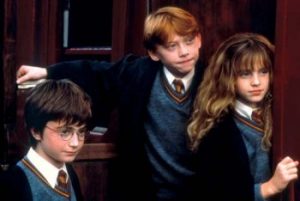Harry Potter and the Philosopher’s Stone on this day of [todaysdate]
Harry Potter and the Philosopher’s Stone, marketed in the United States asHarry Potter and the Sorcerer’s Stone, has proven to be one of the most popular books of the 20th Century and the early 21st Century.

In fact, the movie — “Harry Potter and the Sorcerer’s Stone” — has also proven to be one of the all-time highest grossing films in the U.S. market.
Did you know that sorceror is a mis-spelling for sorcerer?
Did you know that the book was renamed for the U.S. market out of a concern that children might not understand the “philosopher” role in the title? Harry Potter is an example of an interesting phenomenon in linguistics: it illustrates how speakers of one language may gradually split up, divide, and go their own ways.
The English language, for example, is a member of the Germanic family of languages. A long time ago, many thousands of years in the past, there was no English language, no German language, no Dutch, no Norse. Our ancestors spoke a single proto-Germanic language.
Proto-Germanic had a sister language we call Proto-Celtic. The Proto-Celtic language eventually became several languages: Continental Celtic, Manx, Gaelic, Welsh, and Brythonic. The Gaelic language became Irish and Scottish. All of these languages eventually gave rise to special words and names for magical creatures.
J.K. Rowling drew upon fairy-tale lore for several languages to devise the creatures of Harry Potter’s world.
We certainly hope you enjoy browsing our Harry Potter site. Here are a few links to help you get started. You can browse the whole site through the menu at the top of the page, above our masthead.
SEE ALSO: